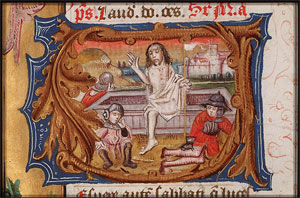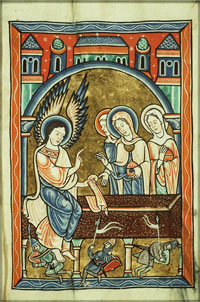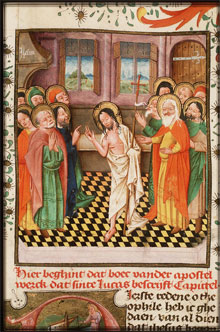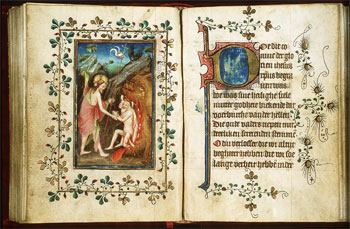This Is What We Preach
For Sunday April 16, 2006
Easter Day
Lectionary Readings (Revised Common Lectionary, Year B)
Acts 10:34–43, Isaiah 25:6–9
Psalm 118:1–2, 14–24
1 Corinthians 15:1–11 or Acts 10:34–43
John 20:1–18 or Mark 16:1–8
 |
Christ steps out of the empty tomb.1 |
Three months ago I stood alone in front of my mother's casket at the Thomas Funeral Home in Fuquay-Varina, North Carolina, a small town near Raleigh where our family moved in 1966. I twisted my neck so that my face would parallel hers. Hot tears streaked down my cheeks, my nose ran, my vision blurred. I caressed Mom's wrist but it was cold and stiff. Thanks to the mortician she looked far better in death than in her last days of life, a spitting image of her own mother, our family agreed. But I knew that her better-than-life appearance was partly a death-denying cultural contrivance designed to dull my pain and distract my attention from the harsh reality that Mom was dead. No more Saturday morning phone calls to ask her about Duke and Carolina basketball, no more annual visits for her May 20 birthday, no more playing Scrabble in her tiny room.
My mother's grandfather was a Presbyterian pastor in Columbiana, Ohio, and she was the organist and choir director in her own church from 1967–1992. Every Sunday morning for the better part of eighty years Mom joined Christians across the last two thousand years and from around the world in confessing the Apostles Creed, that Jesus "suffered under Pontius Pilate, was crucified, died, and was buried. On the third day he rose again from the dead...I believe in the resurrection of the body and in life everlasting." So Paul wrote in the epistle for this week, "This is what we preach, and this is what you believed." (1 Corinthians 15:11). That's what my Mom believed, and that's what I struggled to believe that January afternoon beside her casket.
 |
The three Marys at the empty tomb. |
I take odd comfort in knowing that long before our contemporary scepticism plenty of people dismissed the idea of the resurrection of the dead in general, and of Christ's resurrection in particular. Only with our modern hubris, what the British historian EP Thompson (1924–1993) referred to in another context as "the enormous condescension of posterity," could we congratulate ourselves that whereas illiterate peasants in 33 AD were so gullible that they did not understand that corpses do not rise from the dead, we today know better. The historical record shows that plenty of people disbelieved back then, including Jesus's own disciples. To me the doubt of Jesus's closest followers and the disbelief by many of their contemporaries read more like a "no spin zone" than a propaganda ploy, and lend an air of authenticity to the original Easter proclamation.
After the crucifixion the followers of Jesus responded in fear, confusion, ignorance and disbelief. The women who took spices and perfumes to the tomb that first Sunday morning went to anoint a corpse, not to witness a resurrection. When Mary Magdala saw the empty tomb she supposed that someone had stolen the body: "They have taken the Lord out of the tomb, and we don't know where they have put him!" (John 20:2). She wept and cried: "They have taken my Lord away, and I don't know where they have put him...Sir, if you have carried him away, tell me where you have put him, and I will get him" (John 20:13, 15). When Mary Magdala and several other women subsequently told the disciples that they had seen the risen Lord, "they did not believe it" (Mark 16:11). Luke renders it more bluntly: "They did not believe the women, because their words seemed to them like nonsense" (Luke 24:11). That first Sunday night the eleven disciples cowered behind locked doors (John 20:19), and why not? It was not unreasonable for them to fear for their own lives. Later two witnesses reported their encounter with Jesus to the Eleven, "but they did not believe them either," and even Jesus himself "rebuked them for their lack of faith and their stubborn refusal to believe" (Mark 16:13–14). Thomas remained the most famous Doubter, of course (John 20:24–25), while in what might have been his last resurrection appearance "some doubted" (Matthew 28:17).
 |
Christ appears to the spostles behind closed doors. |
But then something happened. Luke writes that after Jesus suffered, "he showed himself to these men and gave many convincing proofs that he was alive" (Acts 1:3). Somehow, some way, the confusion of these "unschooled and ordinary men" (Acts 4:13) gave way to their bold conviction: "God has raised this Jesus to life, and we are all witnesses of the fact" (Acts 2:32). When commanded by the religious authorities to cease and desist their preaching, Peter and John replied, "We cannot help speaking about what we have seen and heard" (Acts 4:20). They claimed that they had eaten with the resurrected Jesus (Acts 10:41), and that many witnesses could attest to his public appearances (1 Corinthians 15:5–8). So, "with great power the apostles continued to testify to the resurrection of the Lord Jesus" (Acts 4:33). All this, mind you, would have screeched to a halt if someone had produced a body.
Some people believed the apostolic message, but others mocked and scoffed. The religious authorities were "greatly disturbed because the apostles were teaching the people and proclaiming in Jesus the resurrection of the dead" (Acts 4:2). In addition to a burgeoning number of converts, their public witness provoked municipal violence and severe persecution that would last for three centuries. Steven was stoned to death (Acts 7), and a general persecution in Jerusalem scattered believers (Acts 8). King Herod arrested believers, executed James (the brother of John), and imprisoned Peter (Acts 12:1–2). In Iconium "the people of the city were divided" at the message of Paul and Barnabas (Acts 14:4). In Lystra Paul was stoned and left for dead (Acts 14:19), while in Philippi he was imprisoned for "throwing the city into an uproar" (Acts 16:20). Riots erupted in Thessalonica when detractors complained that the disciples had "caused trouble all over the world" (Acts 17:5–6). At Athens some believed Paul's preaching but when others heard about the resurrection of the dead, "they sneered" (Acts 17:32). Riots convulsed Ephesus when "many" adversaries opposed Paul's entourage (1 Corinthians 16:9) and "there arose a great disturbance about the Way" (Acts 19:23). In Jerusalem, of course, only Paul's appeal to his Roman citizenship prevented death by mob violence, but his arrest there sealed his eventual fate (Acts 21). Porcius Festus, the Roman governor of Judea under Nero (59–62 AD), confessed that he was "at a loss" to know what to do with the prisoner Paul: "They did not charge him with any of the crimes I had expected. Instead, they had some points of dispute with him about their own religion and about a dead man named Jesus who Paul claimed was alive." The next day as Paul gave his legal defense Festus interrupted Paul and screamed, "You are out of your mind, Paul! Your great learning is driving you mad" (Acts 25:19–20; 26:24). Peter rebutted charges that he followed a "cleverly invented story" (2 Peter 1:16), while Paul instructed Corinthians who maintained that "there is no resurrection of the dead" for anyone at all (1 Corinthians 15:12). So, there is hardly anything new about contemporary disbelief in the resurrection.
 |
Christ harrows hell. |
I believe the first believers partly because of their chronicle of disbelief—their own and that of their detractors. To me it rings true. They knew from firsthand experience that you cannot compel belief in the resurrection. True, they insisted that their message was "true and reasonable," for the events they described were "not done in a corner" (Acts 26:25–26) but could be corroborated and verified, at least at some level and for a few years. Still, their witness amounted to what Jaroslav Pelikan has called, oxymoronically, "public evidence for a mystery." Paul raised the bar about as high as you can when he insisted that no person should believe a lie about the resurrection, and that they certainly should not preach a lie (1 Corinthians 15:12–19); if Christ is not raised then Christian faith devolves into a cruel hoax. He died in Rome because of that conviction. In the end, Peter challenged, "judge for yourselves" (Acts 4:19).
As I looked at my mother's body, it was a short step from grieving her death to fearing my own death. The Easter message is that I should do neither. The New Testament describes the person and work of Jesus in many ways, but nowhere more succinctly than in Hebrews 2:14–15: "Since the children have flesh and blood, he too shared in their humanity so that by his death he might destroy him who holds the power of death—that is, the devil—and free those who all their lives were held in slavery by their fear of death." With this conviction that Christ "harrowed hell," early believers anticipated the eventual universal restoration of all things (Acts 3:21) when, in the words of Isaiah's poetry for this week, the Lord Almighty will "swallow up death forever. The Sovereign Lord will wipe away the tears from all faces" (Isaiah 25:8).
[1] All images this week are from medieval illuminated manuscripts, © Koninklijke Bibliotheek National Library of the Netherlands.





